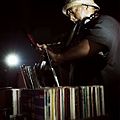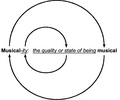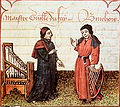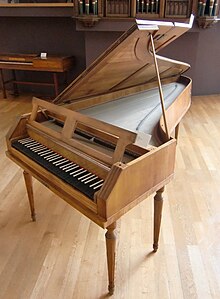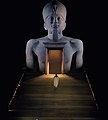Portal:Music
The Music Portal
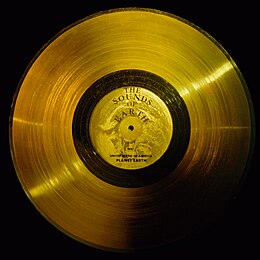
Music is the arrangement of sound to create some combination of form, harmony, melody, rhythm, or otherwise expressive content. Music is generally agreed to be a cultural universal that is present in all human societies. Definitions of music vary widely in substance and approach. While scholars agree that music is defined by a small number of specific elements, there is no consensus as to what these necessary elements are. Music is often characterized as a highly versatile medium for expressing human creativity. Diverse activities are involved in the creation of music, and are often divided into categories of composition, improvisation, and performance. Music may be performed using a wide variety of musical instruments, including the human voice.
Music often plays a key role in social events and religious ceremony. The techniques of making music are often transmitted from as part of a cultural tradition. Music is played in public and private contexts, highlighted at events such as festivals and concerts for various different types of ensembles. Music is used in the production of other media, such as in soundtracks to films, TV shows, operas, and video games.
Listening to music is a common means of entertainment. The culture surrounding music extends into areas of academic study, journalism, philosophy, psychology, and therapy. The music industry includes songwriters, performers, sound engineers, producers, tour organizers, distributors of instruments, accessories, and publishers of sheet music and recordings. Technology facilitating the recording and reproduction of music has historically included sheet music, microphones, phonographs, and tape machines, with playback of digital musics being a common use for MP3 players, CD players, and smartphones. (Full article...)
General images -
-
The Bull Headed Lyre of Ur, found in the Royal Cemetery at Ur, is the best known of the ancient Lyres of Ur (from History of music)
-
c. 379 CE Bas relief of Sassanid women playing the chang in Taq-e Bostan, Iran (from History of music)
-
Stevie Wonder, among the era's innovative artists (from Album era)
-
US vinyl sales in units, 1995–2020; while album sales overall declined, those in the vinyl format rose toward the end of the 2010s. (from Album era)
-
As LPs fell out of favor to CDs, hip hop producers repurposed them as sampling sources, contributing to the development of record collecting. (from Album era)
-
The Rolling Stones in 1967 (from Album era)
-
An example of mechanically printed sheet music (from Music industry)
-
A studio engineer working with an audio mixer in a recording studio (from Music industry)
-
An audience watching a concert (from Music industry)
-
Pink Floyd (1973) performing The Dark Side of the Moon, a leading commercial success of the LP era (from Album era)
-
The monumental Bianzhong of Marquis Yi of Zeng, c. 5th century BCE, from Hubei (from History of music)
-
Terracotta statue of a Parthian lute player (from History of music)
-
Platinum records by Elvis Presley, Prince, Madonna, Lynyrd Skynyrd, and Bruce Springsteen, at Julien's Auctions (from Album era)
-
Taylor Swift, a longtime adherent to album-era rollouts, surprise-released her albums instead in 2020. (from Album era)
-
The Beatles (1964) have been credited by music historians for heralding the album era. (from Album era)
-
Notation indicating differing pitch, dynamics, articulation, and instrumentation (from Elements of music)
-
Circular definition of "musicality" (from Elements of music)
-
Alleluia nativitas by Perotin from the Codex Guelf.1099 (from History of music)
-
Kanye West (2007) emerged during the decade as an important hip-hop producer and album artist. (from Album era)
-
Guillaume Du Fay (left), with Gilles Binchois (right) in a c. 1440 Illuminated manuscript copy of Martin le Franc's Le champion des dames (from History of music)
-
A musician in a recording studio (from Music industry)
-
A live musical performance at Cologne Pride, 2013 (from Music industry)
-
Drawing of the tablet with the Hymn to Nikkal (c. 1400 BCE), the oldest of the Hurrian songs (from History of music)
-
Musicians working in a recording studio (from Music industry)
-
Sheet music for part of the Missa Papae Marcelli by Giovanni Pierluigi da Palestrina (from History of music)
-
Frances Densmore recording Blackfoot chief Mountain Chief on a cylinder phonograph in 1916 (from Music industry)
-
A radio broadcasting system from 1906 (from Music industry)
-
The Japanese boy band Arashi, who had the world's best-selling album (5x20 All the Best!!) in 2019 (from Album era)
-
The logo for Apple Inc.'s online iTunes store, which sells digital files of songs and musical pieces–along with a range of other content, such as digital files of TV shows and movies (from Music industry)
-
The American alternative rock band the Breeders played a tour of thirteen concerts in the central and western United States in September 2014. After the group's "classic" lineup reunited in 2013 for a tour commemorating the 20th anniversary of Last Splash, they began working on new material. Ahead of opening for Neutral Milk Hotel at the Hollywood Bowl, they planned a tour leading up to this show, using the opportunity to practice recent compositions that would appear on their 2018 album All Nerve.
Between September 2 and September 17, the Breeders performed in eleven cities, including St. Louis, Denver, Seattle, Portland, San Francisco, and Las Vegas. Support bands the Funs and the Neptunas opened for them at five and six of these shows, respectively. The group finished the tour on September 20 at the Goose Island 312 Urban Block Party event in Chicago. As well as new songs, they performed numerous selections from Last Splash and Pod. The tour received good reviews from critics; appraisal included comments that the performances were rousing, and that the band was as good as—or better than—in their heyday. (Full article...) -
Fôrça Bruta (Brazilian Portuguese: [ˈfoʁsɐ ˈbɾutɐ] ) is the seventh studio album by Brazilian singer-songwriter and guitarist Jorge Ben. It was recorded with the Trio Mocotó band and released by Philips Records in September 1970. Conceived at a time of political tension in dictatorial Brazil, its title comes from the Portuguese term meaning "brute force" and has been interpreted ironically due to the music's relatively relaxed style.
The album introduced an acoustic samba-based music that is mellower, moodier, and less ornate than Ben's preceding work. Its largely unrehearsed, nighttime recording session found the singer improvising with Trio Mocotó's groove-oriented accompaniment while experimenting with unconventional rhythmic arrangements, musical techniques, and elements of soul, funk, and rock. Ben's lyrics generally explore themes of romantic passion, melancholy, and sensuality, with women figuring prominently in his songs. In a departure from the carefree sensibility of his past releases, they also feature elements of identity politics and postmodernism, such as irony and reimagining of established idioms. (Full article...) -
"No" (stylized in all caps) is a song by American singer-songwriter Meghan Trainor from her second major-label studio album, Thank You (2016). Ricky Reed produced the song and wrote it with Trainor and Jacob Kasher Hindlin; Epic Records released it as the album's lead single on March 4, 2016. A dance-pop song inspired by 1990s pop music and R&B, "No" has lyrics about sexual consent and empowerment, encouraging women to reject unwanted advances from men.
Music critics praised "No" as a showcase of Trainor's confident and mature side and deemed it an improvement from her earlier songs. In the United States, the song reached number three on the Billboard Hot 100 and was certified 2× Platinum by the Recording Industry Association of America. It also reached the top 10 in Australia, Canada, Austria, Israel, Latvia, South Africa, and Scotland, attaining multi-platinum certifications in the former two and Poland. (Full article...) -
Rumours is the eleventh studio album by the British-American rock band Fleetwood Mac, released on 4 February 1977 in the United States and on 11 February 1977 in the United Kingdom by Warner Bros. Records. Largely recorded in California in 1976, it was produced by the band with Ken Caillat and Richard Dashut. The recording sessions took place as the band members dealt with breakups and struggled with heavy drug usage, both of which shaped the album's direction and lyrics.
Recorded with the intention of making "a pop album" that would expand on the commercial success of the 1975 album Fleetwood Mac, the music of Rumours contains a mix of electric and acoustic instrumentation, accented rhythms, guitars, and keyboards; its lyrics concern personal and often troubled relationships. Its release was postponed by delays in the mixing process. The band promoted the album with a worldwide concert tour. Rumours became the band's first number-one album on the UK Albums Chart and also topped the US Billboard 200. The songs "Go Your Own Way", "Dreams", "Don't Stop", and "You Make Loving Fun" were released as singles, all of which reached the US Top 10, with "Dreams" reaching number one. (Full article...) -

Messager in 1921 
André Charles Prosper Messager (French: [mɛsaʒe]; 30 December 1853 – 24 February 1929) was a French composer, organist, pianist and conductor. His compositions include eight ballets and thirty opéras comiques, opérettes and other stage works, among which his ballet Les Deux Pigeons (1886) and opéra comique Véronique (1898) have had lasting success; Les p'tites Michu (1897) and Monsieur Beaucaire (1919) were also popular internationally.
Messager took up the piano as a small child and later studied composition with, among others, Camille Saint-Saëns and Gabriel Fauré. He became a major figure in the musical life of Paris and later London, both as a conductor and a composer. Many of his Parisian works were also produced in the West End and some on Broadway; the most successful had long runs and numerous international revivals. He wrote two operatic works in English, and his later output included musical comedies for Sacha Guitry and Yvonne Printemps. (Full article...) -

Walter Bache
Walter Bache (/ˈbeɪtʃ/; 19 June 1842 – 26 March 1888) was an English pianist and conductor noted for his championing the music of Franz Liszt and other music of the New German School in England. He studied privately with Liszt in Italy from 1863 to 1865, one of the few students allowed to do so, and continued to attend Liszt's master classes in Weimar, Germany regularly until 1885, even after embarking on a solo career. This period of study was unparalleled by any other student of Liszt and led to a particularly close bond between Bache and Liszt. After initial hesitation on the part of English music critics because he was a Liszt pupil, Bache was publicly embraced for his keyboard prowess, even as parts of his repertoire were questioned.
Bache's major accomplishment was the establishment of Liszt's music in England, to which he selflessly devoted himself between 1865 and his death in 1888. This was at the height of the War of the Romantics, when conservative and liberal musical factions openly argued about the future of classical music and the merits of the compositions written in their respective schools. Bache featured several of the orchestral and choral works through an annual series of concerts, which he single-handedly funded, organised and promoted. Likewise, he played an annual series of solo recitals that incorporated Liszt's piano music. (Full article...) -
Ghosts I–IV is the sixth studio album by the American industrial rock band Nine Inch Nails, released by The Null Corporation on March 2, 2008. It was the band's first independent release following their split from longtime label Interscope Records in 2007. The production team included Nine Inch Nails frontman Trent Reznor, studio collaborators Atticus Ross and Alan Moulder, and contributions from Alessandro Cortini, Adrian Belew, and Brian Viglione.
Reznor described Ghosts as "a soundtrack for daydreams," a sentiment echoed by critics, who compared it to the work of Brian Eno and Robert Fripp. The tracks are unnamed, identified only by their track listing and group number, and are almost entirely instrumental. Although conceived as a five-track EP, the final release consisted of four nine-track EPs, totaling 36 tracks. The album was released under a Creative Commons license (BY-NC-SA) and in a variety of differing packages and prices, including a $300 deluxe edition, without prior announcement. A YouTube-based film festival was also announced, inviting fans to visually interpret the music and post their submissions, but no mention has been made of the festival since its announcement. (Full article...) -
The Seduction of Ingmar Bergman is the 22nd album by American rock group Sparks, released in August 2009. The duo's first work in the radio musical genre, the album is built around an imaginary visit to Hollywood by Swedish film director Ingmar Bergman in the mid-1950s. Its storyline focuses on the divides between European and American culture, between art and commerce. Unlike other Sparks albums, the work is conceived as a single piece, to be listened to as a whole, rather than a collection of stand-alone songs.
The work was commissioned by Sveriges Radio Radioteatern, the radio drama department of Sweden's national radio broadcaster. First released in the Swedish broadcast version in August 2009, with an English-language version following in November 2009, it features a cast of Swedish and American actors and a variety of musical styles ranging from opera to vaudeville and pop. The album's recording was a collaborative effort – while the music and English vocals were recorded by Sparks in the United States, the album's Swedish vocals were recorded by Sveriges Radio in Stockholm, and then sent to the Maels via an FTP server. The album and its ambitious dramatic concept received favourable reviews and spawned both a live show and plans to turn it into a film. (Full article...) -
Confusion is a 1975 album by Nigerian Afrobeat musician Fela Kuti and his Africa 70 band. It was arranged, composed, and produced by Kuti, who recorded the album after choosing to emphasize his African heritage and nationalism in his music. Confusion is a commentary on the confused state of post-colonial Lagos and its lack of infrastructure and proper leadership at the time. Kuti's pidgin English lyrics depict difficult conditions in the city, including a frenetic, multilingual trading market and inextricable traffic jams in Lagos' major intersections.
Confusion is a one-song Afrobeat album that begins with an entirely instrumental first half, which features free form interplay between Kuti's electric piano and drummer Tony Allen. It leads to an extended mid-tempo section with Allen's polyrhythms and tenor saxophone by Kuti, who subsequently delivers call-and-response vocal passages. In reviews since the record's release by EMI, the album was praised by music critics, who found it exemplary of Kuti's Afrobeat style and recommended it as a highlight from his extensive catalog. In both 2000 and 2010, Confusion was reissued and bundled with Kuti's 1973 Gentleman album. (Full article...) -
No Line on the Horizon is the twelfth studio album by Irish rock band U2. It was produced by Brian Eno, Daniel Lanois, and Steve Lillywhite, and was released on 27 February 2009. It was the band's first record since How to Dismantle an Atomic Bomb (2004), marking the longest gap between studio albums of their career to that point. The band originally intended to release the songs as two EPs, but later combined the material into a single record. Photographer Anton Corbijn shot a companion film, Linear, which was released alongside the album and included with several special editions.
U2 began work on a new album in 2006 with record producer Rick Rubin but shelved most of the material from those sessions. In May 2007, the group began new sessions with Eno and Lanois in Fez, Morocco, while attending the World Sacred Music Festival. Intending to write "future hymns"—songs that would be played forever—the group spent two weeks recording in a riad, with the producers involved in the songwriting process. The exotic musical influences that the group were exposed to in Fez inspired them to pursue a more experimental sound, but as the sessions unfolded, the band decided to scale back the extent of those pursuits. Having grown tired of writing in the first-person, lead singer Bono wrote his lyrics from the perspective of different characters. Recording continued at several studios in the United States, United Kingdom, and Ireland through December 2008. The group had intended to release No Line on the Horizon in November, but after composing 50 to 60 songs, they delayed the release to continue writing. (Full article...) -
The Dark Side of the Moon is the eighth studio album by the English rock band Pink Floyd, released on 1 March 1973 by Harvest Records in the UK and Capitol Records in the US. Developed during live performances before recording began, it was conceived as a concept album that would focus on the pressures faced by the band during their arduous lifestyle, and also deal with the mental health problems of the former band member Syd Barrett, who departed the group in 1968. New material was recorded in two sessions in 1972 and 1973 at EMI Studios (now Abbey Road Studios) in London.
The record builds on ideas explored in Pink Floyd's earlier recordings and performances, while omitting the extended instrumentals that characterised the band's earlier work. The group employed multitrack recording, tape loops, and analogue synthesisers, including experimentation with the EMS VCS 3 and a Synthi A. The engineer Alan Parsons was responsible for many of the sonic aspects of the recording, and for the recruitment of the session singer Clare Torry, who appears on "The Great Gig in the Sky". (Full article...) -
Guitar Songs is the second extended play (EP) by American singer-songwriter Billie Eilish. It was released through download and streaming services on July 21, 2022, by Darkroom and Interscope Records. The EP marks Eilish's first body of work since Happier Than Ever (2021), her second studio album. Its release came as a surprise, a decision she made because she wanted to share new music to her fans as soon as she could. The track list contains two songs Eilish considered for inclusion in her third album, Hit Me Hard and Soft (2024), but decided not to due to the lyrics' immediacy. She wrote the EP with her brother Finneas O'Connell, who produced both songs.
The two tracks are realist sentimental ballads, a departure from the fantastical themes of Eilish's debut studio album. Each contains personal lyrics that derive from contemporary life events, backed by simple acoustic guitars that emphasize Eilish's soft vocals. Eilish debuted the first track, "TV", during the Manchester concert of a 2022–2023 world tour in support of Happier Than Ever. It references the June 2022 overturning of Roe v. Wade, a court decision that devastated her. "The 30th", the other track, was the first song she made since Happier Than Ever. Written in December 2021, the song is titled after the day of a friend's near-death car crash—on November 30, 2021. (Full article...) -
"Never Forget You" is a song recorded by American singer Mariah Carey for her third studio album, Music Box (1993). Carey co-wrote the slow jam with Babyface and the pair produced it with Daryl Simmons. Columbia Records released the song on January 21, 1994, as the B-side to "Without You" and promoted it to American urban contemporary radio stations as the album's fourth single. The lyrics lament the end of a romance. Strings, synthesizers, and percussion characterize the composition; Jermaine Dupri altered them for remixes.
Music critics deemed "Never Forget You" unremarkable and derivative. The song's level of emotion and Carey's vocal performance were further topics of commentary. "Never Forget You" peaked at numbers one and three on the US urban contemporary radio charts published by Radio & Records and Gavin Report, respectively. It also reached number three on Billboard Hot 100 Singles and number seven on Billboard Hot R&B Singles. Combined with "Without You", the single sold 600,000 copies in the US throughout 1994. (Full article...) -
The Piano Concerto No. 24 in C minor, K. 491, is a concerto composed by Wolfgang Amadeus Mozart for keyboard (usually a piano or fortepiano) and orchestra. Mozart composed the concerto in the winter of 1785–1786, finishing it on 24 March 1786, three weeks after completing his Piano Concerto No. 23 in A major. As he intended to perform the work himself, Mozart did not write out the soloist's part in full. The premiere was in early April 1786 at the Burgtheater in Vienna. Chronologically, the work is the twentieth of Mozart's 23 original piano concertos.
The work is one of only two minor-key piano concertos that Mozart composed, the other being the No. 20 in D minor. None of Mozart's other piano concertos features a larger array of instruments: the work is scored for strings, woodwinds, horns, trumpets and timpani. The first of its three movements, Allegro, is in sonata form and is longer than any opening movement of Mozart's earlier concertos. The second movement, Larghetto, in E♭ major—the relative major of C minor—features a strikingly simple principal theme. The final movement, Allegretto, is a theme and eight variations in C minor. (Full article...) -
Christ lag in Todes Banden (also spelled Todesbanden; "Christ lay in death's bonds" or "Christ lay in the snares of death"), BWV 4, is a cantata for Easter by German composer Johann Sebastian Bach, one of his earliest church cantatas. It is agreed to be an early work partly for stylistic reasons and partly because there is evidence that it was probably written for a performance in 1707. Bach went on to complete many other works in the same genre, contributing complete cantata cycles for all occasions of the liturgical year. John Eliot Gardiner described it as Bach's "first-known attempt at painting narrative in music".
Christ lag in Todes Banden is a chorale cantata, a style in which both text and music are based on a hymn. In this instance, the source was Martin Luther's hymn of the same name, the main hymn for Easter in the Lutheran church. The composition is based on the seven stanzas of the hymn and its tune, which was derived from Medieval models. Bach used the unchanged words of a stanza of the chorale in each of the seven vocal movements, in the format of chorale variations per omnes versus (for all stanzas), and he used its tune as a cantus firmus. After an opening sinfonia, the variations are arranged symmetrically: chorus–duet–solo–chorus–solo–duet–chorus, with the focus on the central fourth stanza about the battle between Life and Death. All movements are in E minor, and Bach achieves variety and intensifies the meaning of the text through many musical forms and techniques. (Full article...)
Selected pictures
-
Photograph: Bain News Service; restoration: Adam CuerdenFranz Lehár (1870–1948) was an Austro-Hungarian composer mainly known for his operettas, the most successful and best known being The Merry Widow. He also wrote sonatas, symphonic poems and marches.
-
Photograph: Avinoam MichaeliAida is an opera in four acts by Giuseppe Verdi to an Italian libretto by Antonio Ghislanzoni. Set in the Old Kingdom of Egypt, it was commissioned by Cairo's Khedivial Opera House and had its première there on 24 December 1871, in a performance conducted by Giovanni Bottesini.
This picture shows the set for a performance of Aida by the Israeli Opera in 2011. -
Photo: W. J. Mayer; Restoration: Lise BroerA bust of the German composer and pianist Ludwig van Beethoven (1770–1827), made from his death mask. He was a crucial figure in the transitional period between the Classical and Romantic eras in Western classical music, and remains one of the most acclaimed and influential composers of all time. Born in Bonn, of the Electorate of Cologne and a part of the Holy Roman Empire of the German Nation in present-day Germany, he moved to Vienna in his early twenties and settled there, studying with Joseph Haydn and quickly gaining a reputation as a virtuoso pianist. His hearing began to deteriorate in the late 1790s, yet he continued to compose, conduct, and perform, even after becoming completely deaf.
-
Photograph credit: William P. Gottlieb; restored by Adam CuerdenMary Lou Williams (May 8, 1910 – May 28, 1981) was an American jazz pianist, arranger, and composer. She wrote hundreds of compositions and arrangements and recorded more than one hundred records. Williams wrote and arranged for Duke Ellington and Benny Goodman, and she was friend, mentor and teacher to numerous other jazz musicians. The second of eleven children, she was born in Atlanta, Georgia, and grew up in the East Liberty neighborhood of Pittsburgh, Pennsylvania. A young musical prodigy, she taught herself to play the piano at the age of three. This photograph of Williams at the piano was taken by William P. Gottlieb around 1946.
-
Photograph: Stefan KrauseHenrik Freischlader (b. 1982) is a German blues guitarist and singer. He began his career in 1998, and established his own label, Cable Car Records, in 2009.
-
Photograph credit: William P. Gottlieb; restored by Adam CuerdenBilly Strayhorn (November 29, 1915 – May 31, 1967) was an American jazz composer, pianist, lyricist, and arranger, best remembered for his long-time collaboration with bandleader and composer Duke Ellington that lasted nearly three decades. Though classical music was Strayhorn's first love, his ambition to become a classical composer went unrealized because of the harsh reality of a black man trying to make his way in the world of classical music, which at that time was almost completely white. He was introduced to the music of pianists like Art Tatum and Teddy Wilson at age 19, and the artistic influence of these musicians guided him into the realm of jazz, where he remained for the rest of his life. This photograph of Strayhorn was taken by William P. Gottlieb in the 1940s.
-
Photograph: Sven-Sebastian SajakHayley Williams (born December 27, 1988) is an American singer, songwriter, musician, and businesswoman. She serves as the lead vocalist, primary songwriter and occasional keyboardist of the rock band Paramore. Born in Meridian, Mississippi, Williams moved to Franklin, Tennessee, at the age of fifteen after her parents divorced. In 2004, she formed Paramore alongside Josh Farro, Zac Farro, and Jeremy Davis. The band currently consists of Williams, Farro and Taylor York. They have released five studio albums: All We Know Is Falling (2005), Riot! (2007), Brand New Eyes (2009), Paramore (2013) and After Laughter (2017).
-
Photograph: AiluraNina Sublatti (b. 1995) is a Georgian singer, songwriter, and model. Having previously won the 2013 Georgian edition of Idol, she achieved international attention when she represented her country in Eurovision Song Contest 2015 with her song "Warrior". She has since served as a judge on X Factor Georgia and Idols.
-
Drawing credit: Philippe Chaperon; restored by Adam CuerdenAida is a grand opera in four acts by Giuseppe Verdi to an Italian libretto by Antonio Ghislanzoni. Set in the Old Kingdom of Egypt, it was commissioned by Cairo's Khedivial Opera House and had its premiere there on 24 December 1871, in a performance conducted by Giovanni Bottesini. Today, the work holds a central place in the operatic canon, receiving performances every year around the world; at New York's Metropolitan Opera alone, Aida has been sung more than 1,100 times since 1886.
This picture is the set design for Act 1, Scene 2, of the opera's 1871 premiere, depicting the portico of the Temple of Vulcan, designed by Philippe Chaperon. The drawing is in the collection of the Bibliothèque nationale de France. -
Photograph: Sven-Sebastian SajakMike Dirnt (b. 1972) is an American musician, songwriter and composer. He is best known as the co-founder, bassist, backing and occasional lead vocalist of American punk rock band Green Day. He has played in several other bands, including The Frustrators.
-
Hera is an Icelandic singer-songwriter who emigrated to New Zealand as a teenager. She is known for her facial art, which is "inspired by moko and also by Celtic warrior paint" and intended to represent both her Icelandic and New Zealand heritage. In 2002 she was named Best Female Singer at the Icelandic Music Awards.
-
Illustration credit: unknownAriadne auf Naxos ('Ariadne on Naxos'), Op. 60, is an opera by Richard Strauss with a German libretto by Hugo von Hofmannsthal. Combining slapstick comedy and consummately beautiful music, the opera's theme is the competition between high and low art for the public's attention. The opera was originally conceived as a 30-minute divertissement to be performed at the end of Hofmannsthal's adaptation of Molière's play Le Bourgeois gentilhomme. Besides the opera, Strauss provided incidental music to be performed during the play. In the end, the opera was ninety minutes long, and the performance of the play and opera together totalled over six hours. It was first performed at the Staatsoper Stuttgart on 25 October 1912, directed by Max Reinhardt. The combination of the play and opera proved to be unsatisfactory to the audience: those who had come to hear the opera resented having to wait until the play finished. The work was revised in 1916, with the play being replaced by a prologue, and first performed at the Vienna State Opera on 4 October of that year.
This picture is the cover of a vocal score of the revised edition of Ariadne auf Naxos, published in 1916. -
Photograph: Georg Lindstrøm; restoration: Adam CuerdenCarl Nielsen (1865–1931) was a Danish musician, conductor and violinist, widely recognized as his country's most prominent composer. Initially playing in a military band before attending the Royal Danish Academy of Music in Copenhagen, he premiered his Op. 1, Suite for Strings, in 1888, at the age of 23. His early music was inspired by composers such as Brahms and Grieg, but he soon developed his own style. By the time of his death, he had produced 419 known works; some of these, such as his opera Maskarade (1906), have become integral to Denmark's national heritage.
-
Photograph credit: Fritz Luckhardt; restored by Adam CuerdenJohann Strauss II (25 October 1825 – 3 June 1899) was an Austrian composer of light music, particularly dance music and operettas. Part of the Strauss dynasty, his father demanded that none of his sons pursue music as a career, despite their display of musical talent. It was only after his father had abandoned the family for a mistress that the younger Strauss was able to develop his skills as a composer, with the encouragement of his mother. He eventually attained greater fame than his father, and became one of the most popular waltz composers of the era, conducting extensive tours of Austria, Poland and Germany with his orchestra.
-
Alexz Johnson (b. 1986) is a Canadian singer-songwriter and actress, best known for roles as Jude Harrison in the CTV series Instant Star (character shown here), Annie Thelan in the Disney Channel series So Weird, and as Erin Ulmer in the 2006 horror film Final Destination 3. Her album Voodoo was released in 2010.
Related portals
Did you know (auto-generated)

- ... that Wilner Burke was the director of the Lumberjack Band, the marching band of the Green Bay Packers, for 42 years?
- ... that a will bequeathing the Chestnut Street Opera House to the University of Pennsylvania was contested at the Supreme Court of Pennsylvania?
- ... that Oksana Lyniv founded the Youth Symphony Orchestra of Ukraine in 2016 and conducted them in thirty concerts across ten music festivals in 2022?
- ... that the Soviet soprano Tamara Milashkina performed alongside her husband Vladimir Atlantov at New York's Metropolitan Opera in 1975?
- ... that Felipe Lara's Pulitzer finalist Double Concerto turns its soloists into a "many-tentacled creature"?
- ... that husband and wife Edward M. and Marie Zimmerman co-wrote the suffragist anthem "Votes for Women: Suffrage Rallying Song"?
Today's Birthdays
- Birthdays in Music: July 9
- Haruomi Hosono, Japanese musician with Yellow Magic Orchestra, turns 77.
- John Tesh, American composer, turns 72.
- Debbie Sledge, American disco music singer of Sister Sledge fame, turns 70.
- Jim Kerr, Scottish lyricist for Simple Minds, turns 65.
- Marc Almond, Brit synthpop singer with Soft Cell, turns 65.
- Courtney Love, American vocalist with Hole, turns 60.
- Frank Bello, American bassist with Anthrax, turns 59.
- Nikola Šarčević, Swedish bassist and singer with Millencolin, turns 50.
- Ella Koon, Hong Kong singer and actress, turns 45.
- Lucia Micarelli, American classical music performer, turns 41.
- Kiely Williams, American girl group vocalist with 3LW, turns 38.
Categories
Explore
Connections
WikiProjects connected with music: WikiProject Music – Songs – Albums – Alternative music - Classical music – Composers – Contemporary Christian music – Contemporary music – Electronic music – Emo music – Hip hop – Instruments – Led Zeppelin - Metal music – Jazz – Musicians – Opera – Panic at the Disco – Powderfinger (band) – Punk music – Record Labels – Record Production – Rock music – R&B and Soul Music – Terminology – The Beatles
Create a requested article: See the list of Requested articles.
Improve an article: See the Music Noticeboard for a list of tasks.
Start a music course: School of Music at Wikiversity
Associated Wikimedia
The following Wikimedia Foundation sister projects provide more on this subject:
-
Commons
Free media repository -
Wikibooks
Free textbooks and manuals -
Wikidata
Free knowledge base -
Wikinews
Free-content news -
Wikiquote
Collection of quotations -
Wikisource
Free-content library -
Wikispecies
Directory of species -
Wikiversity
Free learning tools -
Wikivoyage
Free travel guide -
Wiktionary
Dictionary and thesaurus





